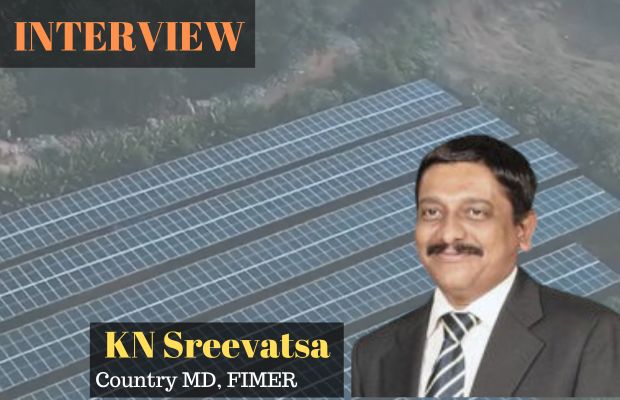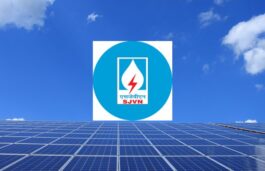Highlights :
In an interview with Saur Energy, KN Sreevatsa, Country Managing Director (MD) of FIMER talks about the journey of the firm, its major key projects in the country, challenges and its future plans. Excerpts from the interview:
 FIMER's Made In India Inverters Shine In Key Indian PV Projects: KN Sreevatsa, MD
FIMER's Made In India Inverters Shine In Key Indian PV Projects: KN Sreevatsa, MD 1.How was the year 2023 for FIMER in India
In 2023, FIMER achieved a groundbreaking feat by securing its first major order of the year — a substantial 2.45 GW contract from a single client at a specific location in India. This was particularly significant as it involved the successful conclusion of the NTPC Phase I & Phase II Khavda project. FIMER’s role in this project, utilizing the advanced FIMER PVS-980 5MW inverters, solidified its status as one of the few Class-I suppliers approved by NTPC for such projects.
In addition to securing the 2.45 GW contract and achieving remarkable milestones in 2023, FIMER distinguished itself through several exceptional projects. Notably, the solarisation of the ‘Sun Temple town of Modhera’ in Gujarat showcased FIMER’s commitment to harnessing renewable energy for cultural and historical landmarks. Additionally, FIMER played a crucial role in the Sanchi city project.
In the realm of Battery Energy Storage Systems (BESS), FIMER continued its streak of outstanding projects by supplying its Bi-directional converters PVS980-58BC series to the Indian Army in Leh Ladakh. This contribution exemplifies FIMER’s dedication to providing robust solutions for critical applications, particularly in challenging terrains and extreme conditions.
2. How FIMER aided in corporate sustainability?
FIMER’s involvement in the corporate sustainability initiative was exemplified through its partnership with Capgemini. By supplying inverters to power Capgemini’s office campuses, FIMER contributed to the realization of corporate sustainability goals. The company’s impact extends beyond conventional solar projects, reinforcing its reputation as an innovative and versatile leader in the renewable energy sector.
3. As one of the strongest names in the central inverter space with a domestic manufacturing base to boot, how are seeing the prospects for 2024? Are all the supply side issues behind us?
FIMER proudly highlights that its central inverters are manufactured at the ‘Made in India’ facility in Bengaluru. FIMER’s extensive product range includes central inverters, string inverters, and microgrid solutions. The company prioritizes high performance, reliability, and efficiency in its offerings. The outlook for 2024 appears promising for FIMER, buoyed by the anticipation of numerous projects in the pipeline. The major order pipeline for projects scheduled for commissioning and installation in the current year reflects the company’s strong position in the market. FIMER is also revamping production capacity up to 15GW to meet the rising demand for renewable energy solutions.
4. How is the market evolving for your B-directional converter in the BESS space? How big do you see that becoming?
FIMER’s contribution to the energy storage sector is notable, particularly with the supply of its BESS-compatible inverters, the PVS980-58BC 2 MVA, for two Capgemini office campuses. These inverters played a crucial role in the implementation of a 3.5 MW BESS system by Arcedo System in Mumbai and another 2.5 MW system by Replus Engitech in Noida, both successfully commissioned in 2023.
The FIMER PVS980-58BC bidirectional converters have proven to be well-suited for large-scale energy storage systems, providing a solution to enhance grid stability for power plants dealing with intermittent energy sources. The converters boast features such as high DC input voltage, efficiency, reliable components, and a compact modular design, all contributing to a swift return on investment.
This energy storage solution facilitates the efficient storage of excess renewable energy generated during the day, allowing for its utilization during evening peak hours. Moreover, the Power Conversion System (PCS) associated with these inverters proves to be versatile, offering support during periods of insufficient solar energy by meeting load demand.
5. We understand FIMER has been behind some high-visibility, prestigious projects in India? Can you name a few?
In the ’40MW Ayodhya Solar PV Project,’ developed by NTPC Green Energy Ltd., FIMER supplied cutting-edge 5 MVA inverters (PVS980-58).
The city of Sanchi in Madhya Pradesh, a UNESCO World Heritage Site, is on its way to becoming Madhya Pradesh’s first “solar city.” In the first stage of the project, a 3 MW solar plant was installed and commissioned to meet the city’s energy needs. For this phase, FIMER’s 3 MW PVS980-58 central inverter was selected. The PVS980-58 central inverter serves as the cornerstone of Sanchi’s “solar city” project, ensuring efficiency, reliability, and optimal performance for the solar plant.
FIMER’s recent accomplishment involves the supply of its 1MVA inverters for the successful execution of the Integrated Solar Energy Project at the Sun Temple Town of Modhera in District Mehsana, Gujarat. This groundbreaking project stands as India’s first integrated state-of-the-art Solar Project. Notably, it was completed within a year, showcasing efficiency and swift execution. The project itself is an impressive 6 MW grid-connected system complemented by a substantial 6MVA BESS system, featuring an 18 MWh Battery Energy Storage System.
This BESS is recognized as one of the largest in operation in India, marking a significant stride towards utilizing solar energy for sustainable power solutions. FIMER’s contribution to this project further underscores its commitment to advancing renewable energy initiatives in the country.
5. Do you see the utility segment dominating in the near future in India, or will it cede ground to solar rooftops at some stage, as we see in developed markets?
India now houses multiple ultra-mega solar parks with a capacity of more than 1GW, and two of them are the largest commissioned in the world to date. The solar parks in India continue to attract global capital and some of the most renowned domestic and international renewable energy developers.
Rooftop solar is an important market segment of India’s solar sector. It comprises on-site solar installations connected in a behind-the-meter (BTM) configuration on the consumer’s premises. It provides buyers a viable option to green their electricity consumption by procuring on-site cheaper and cleaner renewable energy.
There are several major roadblocks hindering the growth of the rooftop solar market in India. These include regulatory issues, such as inconsistent net metering policies across states. Net metering is a crucial parameter that influences the financial viability of a rooftop solar plant. In addition to regulatory concerns, financing continues to be a major challenge for the rooftop solar market.
Whereas utility-scale solar parks in India have successfully overcome the three major risks associated with renewable energy development in India, namely project execution risk, off-taker risk and operation and maintenance risk.
6. Many manufacturers outside China in the solar panel’s supply chain have cited a threat to viability due to low prices. Is that a real threat in the inverter space as well?
China has indeed become a dominant player in the global solar PV market, surpassing Europe, Japan, and the United States in manufacturing capacity and investment. While China’s contributions have had positive effects on making solar energy more affordable worldwide, the concentration of manufacturing in one region also raises challenges. Geographical concentration in global supply chains can pose risks, including supply chain disruptions and potential dependence on a single region.
FIMER’s commitment to offering good quality products sourced from reputed component manufacturers is essential in building trust among customers. The reliability, sturdiness, and high performance of our inverters, even in challenging environments such as extreme cold temperatures, high-risk zones, and high altitudes, are noteworthy achievements. The fact that some of the first inverters provided in the Indian market a decade ago are still performing well speaks volumes about the durability and longevity of our products.
7. How do you see the domestic manufacturing market for inverters in India evolving? Can we target self-sufficiency in this market too by say 2027?
As for achieving self-sufficiency in the inverter market by 2027, it depends on the collective efforts of the government, industry stakeholders, and market dynamics. If the right policies are in place, investments continue to flow, and there is a strong commitment to quality and innovation, self-sufficiency is a plausible goal. The industry’s ability to scale production, reduce costs, and compete globally will determine the level of self-sufficiency achieved.
The evolution of the domestic manufacturing market for inverters in India has been influenced by various factors. The Indian government has been emphasizing initiatives like “Make in India” to boost domestic manufacturing across sectors, including renewable energy. The development of the domestic manufacturing market for inverters depends on several key elements—support to the industry through good government policies, investments in research and development, quality standards and skill development.



























